
Sex, Scandal, and Allure: The Erotic Art of Shun-ga from Edo to Early Modern Japan
In the year 1770, within a large village house by the bustling city of Edo, Japan (modern day Tokyo City), a large collective of apprentices studied under their teacher, Utagawa Toyoharu, in observation of his mastery of the Ukiyo-e style. Though these young artists were expected to master it, they used it to create something else far more provocative. At a point in their future professional careers, they were all commissioned to create shun-ga.
Shun-ga is a term which literally translates to ‘spring pictures’. It has its roots from the Chinese term Chungong Hua (Spring Palace Pictures). A lot of the inspiration can be traced to the Japanese Heian period (794 AD -1185 AD), as well as from the Chinese Tang Dynasty (618 AD - 907 AD) from its ancient literature and art.
With the fusion of both Utagawa Toyoharu’s Ukiyo-e style and Tang Dynasty era Zhou Fang’s expressionistic exaggeration of genitalia (730 AD - 800 AD), the art form known as shun-ga was conceived. This stylistic movement sought to express an erotic idealization of the urban life during the Edo period.
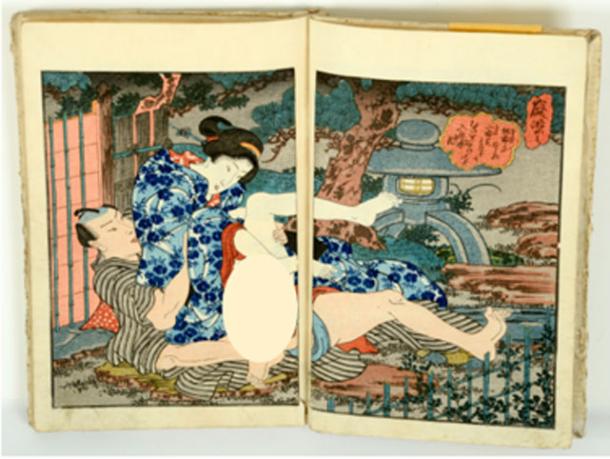
An example of shun-ga erotic art. Credit: fotoember / Adobe Stock
The allure of shun-ga is well known to any who have studied Japanese art. Though, it is not their visual portrayal of lewd acts which makes them so sought after. It is both the history and the continuous controversy they bring when discussing the multi-faceted nature of changing culture.
This is what makes them so desirable today.
The art of shun-ga relied on the creation of carved wooden blocks, followed by an entire industry of printers, draftsmen, writers, and distributors. Shun-ga was either a single sheet of art with an erotic poem written on it, or an entire book of erotic literature with art included (the book form is known as koshokubon, or ‘lewd books’). This was an artform which appealed to the rising merchant and artist class of Edo Japan, or ‘Chonin Class’.
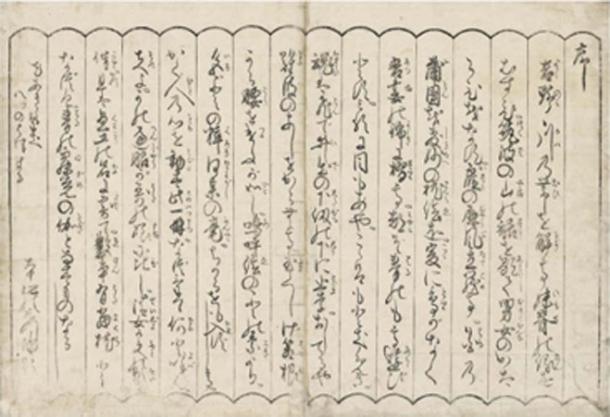
A page of ‘The Poem of the Pillow’ from the erotic shun-ga book Utamakura. (Curly Turkey / Public Domain)
So how could it be that in feudal Edo Japan a socially provocative form of art existed in the midst of a strict and oppressive state? How could shun-ga, which in today’s world is seen as the ancient form of pornography, have been so prominent and popular during this time? To fully comprehend why shun-ga became so prevalent, it’s important to understand the Edo period itself to understand how shun-ga could prosper.
The Edo Period and Shun-ga
The Edo period of Japan (1603-1868) was during the reign of the Tokugawa. Though strict in its rules, and hesitant in its foreign policies, this was considered a time of cultural maturation, especially in the creative arts and entertainment.
Edo period Japan experienced an economic boom leading to increased shipping commodities, a significant expansion of both domestic and foreign commerce (though heavily restricted), and the creation of artisanal handcraft industries. It would see the rise of the Chonin: an emerging upper middle class primarily made of merchants and industrial craftsmen.
The development of the Chonin class allowed for people to have more leisure time. This resulted in many partaking in the act of Ukyo (the floating world); a word associated with glamor, fashion, entertainment, and the discovery of aesthetic qualities in objects and actions of everyday life. With a blossoming middle class and a strong economy, the traditional concepts of feudal society were starting to change.
- The Allure of Blackened Teeth: A Traditional Japanese Sign of Beauty
- Sensu and Tessen in Combat: A Japanese Fan Became a Deadly Weapon In the Right Hands
- Rare ritual jars found buried under ancient ruins in Japan intended to purify, bring eternal youth
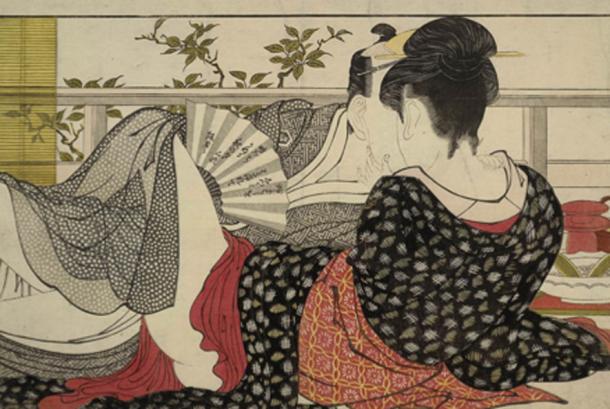
A page from the erotic shun-ga book Utamakura. Source: Curly Turkey / Public Domain.
Shun-ga gave insights into the imagination of the artists who created them. As one views their history and literary sources, one can attain a clearer understanding of how it was enjoyed by all classes of Edo society. These items were either in the form of art or literature; fusing a perfect balance of both humor and sexuality given at a palatable pace.
It was common practice to lend and borrow shun-ga books from friends and families. Commercial lending libraries were developed exclusively for the distribution of shun-ga. It was also very common for traveling book merchants to appear door to door selling shun-ga for a moderate price.
Due to its popularity, shun-ga was mass produced in enormous quantities in both paintings and in literary prints. More than two thousand titles of shun-ga erotic literature existed. In the years to come, Edo period Japan would face political turmoil, massive famines, and tenacious pressure in the form of western influence. This period in Japanese history would also show a massive shift in what was accepted.
Transition of Edo Japan and Shun-ga
Though most scholars would focus on the lewd and provocative depictions of sexuality, it is actually the stories and narratives which make shun-ga most notable.
At first glance, a shun-ga might not appear to be the result of mass production. But the intensity of creating shun-ga itself involved a complex relationship between the artists who painted the concepts, the craftsmen who cut the wooden blocks, the print makers who assembled the prints, the writers who created the stories, the publishers who provided the financing, and finally the consumer who purchased the finished product.
Shun-ga was an industry with an intricate division of labor that fed the needs in all levels of Edo society. The most prevalent of shun-ga narratives depicted the sexual relationships of ordinary people, townsmen, women, merchants, artists, and laborers. In the years to come during the Meiji period, the narratives would include people in western clothing, and journeys to foreign lands.

A man with a Western-style haircut makes love to a woman in traditional Japanese dress in this Meiji period shun-ga print. (Materialscientist / Public Domain)
A few examples are noted by the senior curator of east and central Asian arts at the British Museum, Rosina Buckland:
“…a wife catches her husband seducing a maid, a couple are spied on by a curious servant, and mice start copulating in imitation of the humans […] The erotic encounters depicted in shun-ga reflect multiple perspectives - male, female, heterosexual, and same-sex...”
As with all good literature (even erotic literature), the essence of shun-ga storytelling was through the exaggeration of playful situations leading to the act of intimate copulation. Shun-ga literature carried immense satire. It sometimes drew on the controversy of censorship and regulations of the time, as well as narratives exploring the awkwardness of common day etiquette.
In 1722, the Tokugawa government (Edo period) attempted to ban the publication of shun-ga books. The Kyoho reforms would lead to the restriction of the production of all new shun-ga erotic books unless given approval by the city commissioner. The restriction assumed that artists and writers would comply and not produce any more.
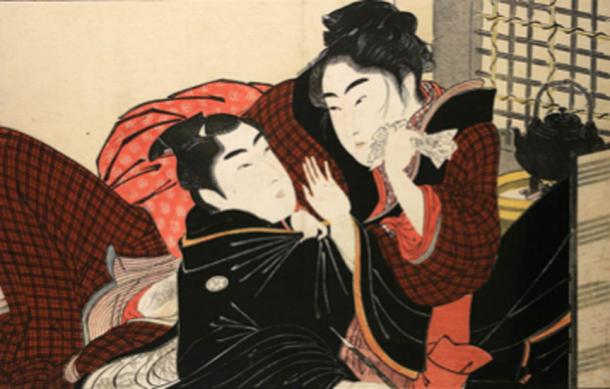
The Tokugawa government attempted to stop the publication of shun-ga books. (Curly Turkey / Public Domain)
However, visual paintings were never truly censored, since it was mainly the literature and the already existing printed series that the Tokugawa government wanted stopped. The discrete dissemination of newer shun-ga spread rampantly among the lower classes of Edo society, suggesting that the ban may not have been as enforceable as assumed. But with a tradition of shun-ga that had been so readily available until the latter half of the Edo period, what could have caused the Tokugawa government to continually attempt to stop its production?
Is Shun-ga Pornography or Art?
Japanese scholars who analyze the sexually explicit nature of shun-ga, pay close attention to the consumers of shun-ga during the Edo period. Most Japanese scholars would agree that it’s modern day parallel would be that of pornography, erotic photography, and literotica (erotic literature). Because of this assumption there is a continuous cultural bias that shun-ga should be treated no differently. The contemporary image of shun-ga as early pornography conjures images of its use for sexual stimulation, degrading the virtuous image of a stoic Edo Japan.
However, these biased assumptions were the result of cultural shifts in the later years of Japan’s history. The controversial debate as to whether shun-ga was pornography or art has been a continuous discussion in the academic arena. As Hayakawa and Gerstle state in their works, “Pornography is usually taught to be aimed primarily at men for their private use […] however, in shun-ga there are many images of women enjoying shun-ga, presenting a discourse that it was natural for women to look at shun-ga”.
- The Chrysanthemum Throne: A Two and a Half Millennia History of Divine Imperial Rule in Japan
- Hoard of Scrolls and Artifacts Discovered in Antique Japanese Statuette
- Shinigami: The Grim Reaper and God of Death in Japanese Folklore
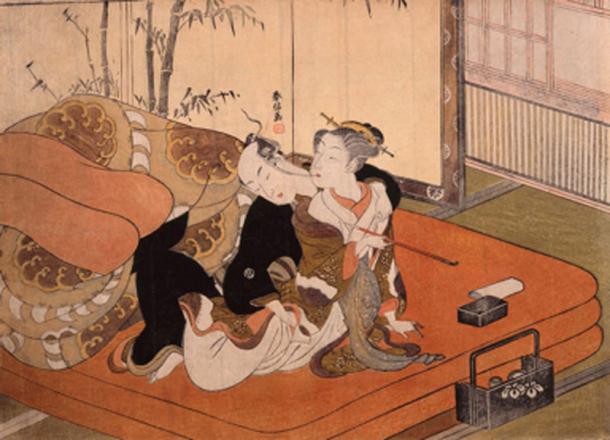
Shun-ga exhibition Tokyo 2015. (CFCF / Public Domain)
Monta Hayakawa and Andrew Gerstle explored the changing attitudes towards Shun-ga. One perspective they addressed is with shun-ga’s largest consumer: women. Women obtained shun-ga by themselves as well as had it given to them as bridal presents. Women were not embarrassed or pressured into its acquisition. If shun-ga was lewd and smut, it would have been socially unacceptable for women of note to carry such things, however the evidence shows otherwise.
In some written documents, shun-ga acted as a symbol of luck for people in all levels of society. It acted as a protective lucky charm against fire for merchant warehouses. Shun-ga was also an instrument which helped people with loneliness in both eroticism and in entertainment.
Hayakawa and Gerstle also noted that in the highest-ranking members of Edo society, noble samurai commissioned shun-ga scrolls to be pasted on the back of chest armor. This was to act as an omen of good faith and protection against harm. The intelligentsia of Edo society were also noted for enjoying shun-ga for its erotic art and humorous literature. As more research continues, there is a growing theory that families during the Edo period of Japan may have been more open to the discussion of sexuality.
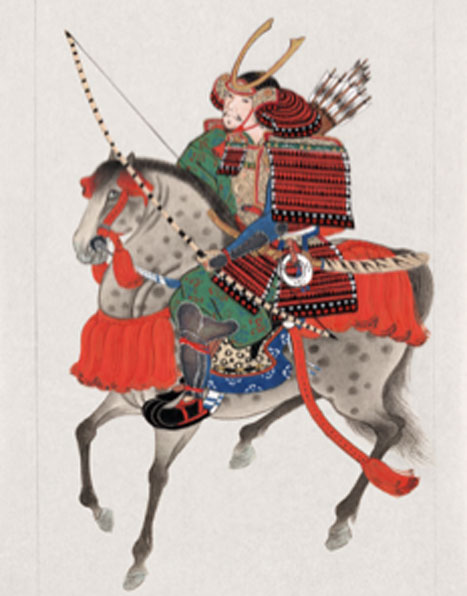
In Edo society noble samurai commissioned shun-ga scrolls to be pasted on their armor. (Brandmeister~commonswiki / Public Domain)
In the diary entry of the Tokugawa official magistrate Kawaji Toshiakra (1801-1868), writings of his family conversations described no end on the topic of sexuality and the exploration of sensual acts. Sex and shun-ga was openly discussed between his wife, his sons, servants, and adopted children.
Though some scholars may argue that the Kawaji household may have been a unique outlier, the history and reputation of the magistrate would say otherwise. Kawaji was noted to be one of the most loyal and shining star examples of how an appropriate Edo nobleman was supposed to be.
With all accounts from his diary entries, as well as notes from various other families from lower classes, one could safely assume that the attitudes of sexuality were not as stringent until later years. With the beginning of the Meiji period of Japan, immense cultural change would come in all forms.
With the changing of the times, in 1868 many adopted new technologies and attitudes. Those who would resist it would disappear along with the Edo period.
In the case of the Magistrate Kawaji Toshiakra, on March 15th, 1868, Kawaji took his own life in the act of ‘seppuku’. Japan saw a complete transformation. Its ways of government and culture shifted as they adopted a complete ‘westernization’ to stay relevant in the changing modern world. As the technology changed, so would the cultural views of Shun-ga.
The Meiji Period and Shun-ga
During the height of the Meiji era (1868-1912), Japan embraced a full adoption of western scientific, technological, legal, political, and aesthetic ideas. In the opinion of the Meiji era Japanese, this was an act of survival against the threat of European colonization.
The hindering result of this absolute adoption of western ideals was a dramatic push to finally get rid of the feudal system and create a unified Japanese government free of the shogunate and samurai lords. As history would show, some would adapt, but many would fight the changes only to perish. (see Saigo Takamori and the samurai rebellion in Kyushu).
For a brief time during the Meiji period, shun-ga adapted and used western art techniques such as perspectives and vanishing points. There was newer literature that focused on Japanese figures and how they dealt with western clothing.
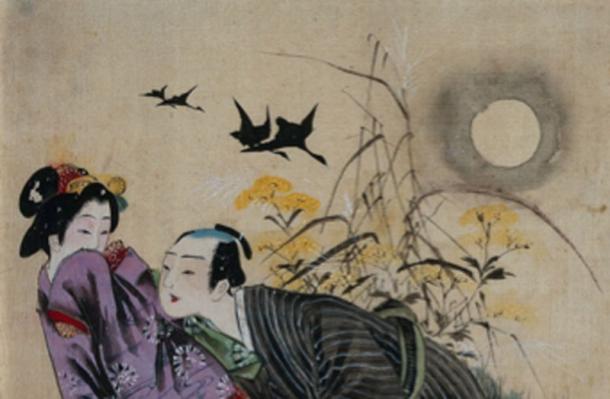
A man seducing a woman beneath an autumn moon. Shun-ga in the style of the Meiji period. (Fæ / Public Domain)
However, the Japanese under the Meiji period, oversaw a complete reinvention of itself to be in parallel thinking with the west. The growing attitudes toward shun-ga was that it was shameful.
Shun-ga artists became more self-conscious about producing such works and preferred to be unnamed due to the emerging stigma it carried. However, this did not destroy shun-ga. In the end it was technology and not shameful sentiment that killed shun-ga.
Its production became harder, using the traditional method of wood block printing, when attempting competition against the faster western techniques of photo-reproduction. Alternate techniques and technologies became more available to artists. The shun-ga art form became fated with obsolescence. The art of shun-ga was soon phased out in Japan as its main source of erotica.
Though this style of shun-ga disappeared, it acted as an influence for the techniques of Showa (1926-1989) and Heisei (1989-present) art styles. These modern iterations are prevalent in contemporary manifestations such as video games, anime, and Manga (or better known as Hentai).
It is ironic that no matter how hard a culture would try to rid itself of its erotica, that it is almost always the advancement of technology that succeeds in its demise. (See pornography magazine prints vs. the internet). Is it then, when erotica is in danger of disappearing, that it becomes a desirable item? In the case of Shun-ga, that would seem so.
Top image: Japanese erotic art. Credit: fotoember / Adobe Stock
By B.B. Wagner
References
Artsy Editors. 2013. What is Shunga? Artsy. [Online] Available at: https://www.artsy.net/article/editorial-what-is-shunga
Buckland, R. 2010. Shunga: Erotic Art in Japan. British Museum Press.
Clark, J. 2012. Modern Japanese Art and the Meiji State: The Politics of Beauty. Asian Studies Review. [Online] Available at: https://www.researchgate.net/publication/254223332_Modern_Japanese_Art_and_th_Meiji_State_The_Politics_of_Beauty
Clark, T., Et al. 2014. Shunga: Sex and Pleasure in Japanese Art. Brill/ Hotei Publishing.
Hayakawa, M. and Gerstle, A. 2013. Who were the Audiences for “Shunga?”. Japan Review. [Online] Available at: https://www.jstor.org/stable/41959815?seq=1#page_scan_tab_contents
Johnson, K. 2008. Fleeting Pleasures of Life in Vibrant Woodcut Prints. The New York Times. [Online] Available at: https://www.nytimes.com/2008/03/22/arts/design/22prin.html?mtrref=www.google.com&gwh=12A41B5F8BF25711046132472DA95E96&gwt=pay
Kazutaka, H. and Haft, A. 2013. No Laughing Matter: A Ghastly “Shunga” Illustration by Utagawa Toyakuni. Japan Review. [Online] Available at: https://www.jstor.org/stable/41959826?seq=1#page_scan_tab_contents
Moretti, L. 2012. The Japanese Early Modern Publishing Market Unveiled: A Survey of Edo-Period Booksellers’ Catalogue in East Asian Publishing and Society. Brill. [Online] Available at: https://brill.com/view/journals/eaps/2/2/article-p199_2.xml
Ronin Gallery. Date Unknown. Intimate Moments. [Online] Available at: https://www.roningallery.com/exhibitions/intimate-moments
Ryōko , M. 2013. Kabuki and Violence in Edo Shunga – Kabuki Actors in Erotic Books (Shunpon). Japan Review. [Online] Available at: https://nichibun.repo.nii.ac.jp/?action=pages_view_main&active_action=repository_view_main_item_detail&item_id=176&item_no=1&page_id=41&block_id=63
Ryoko, M. 2013. Shunga: Sex and Humor in Japanese Art and Literature. Japan Review. [Online] Available at: https://www.jstor.org/stable/i40091571
Screech, T. 2009. Sex and the Floating World: Erotic Images in Japan, 1700-1820. Reaktion Books.
Shunga Shop. Date Unknow. Brief history of shunga. [Online] Available at: https://www.shunga.shop/brief-history-of-shunga/
Stanska, Z. 2017. All You Must Know About Japanese Erotic Art, Shunga. Daily Art. [Online] Available at: https://www.dailyartmagazine.com/must-know-japanese-erotic-art-shunga/
Time Out Tokyo Editors. 2015. Shaking up the shungo taboo. [Online] Available at: https://www.timeout.com/tokyo/art/shaking-up-the-shunga-taboo
Voon, C. 2015. Intricate, Beautiful, Raunchy: Japan Embraces Its Ancient Erotic Print Tradition. Hyperallergic. [Online] Available at: https://hyperallergic.com/240689/intricate-beautiful-raunchy-japan-embraces-its-ancient-erotic-print-tradition/















